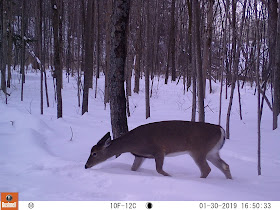Deep snow can make winter survival difficult for white-tailed deer. Getting around is difficult and requires more energy. Most of the food sources are inaccessible, especially if the snow is combined with a layer of ice that prevents deer from digging down to the ground.
Because foods such as grasses, forbs, and nuts are often unavailable, deer survive mostly on a diet of browse (buds, leaves, branch tips) during the winter months. Where deer populations are heavy, all the food that is easy to reach is already gone by this time of winter. Sometimes the only food left available in area is high overhead. It is not unusual to see where deer have browsed as high as eight feet off the ground by standing on their hind legs.
I retrieved my trail cameras this afternoon and was lucky enough that one of the cameras had recorded this behavior. The deer in this series of images is reaching up to eat needles from an Eastern Hemlock (Tsuga canadensis).
Normally I just change out the memory cards in my trail cameras and leave the cameras in the woods, but I decided to remove the cameras completely for now. Even though its in a public park, the area that I place the cameras is quite secluded when the ground is not frozen - it's in the middle of a swamp. However, right now its easy to access because everything is frozen over. I also left a trail of footprints directly to the camera sites. I also recorded a person on one of the cameras. This is not the first time I have ever seen a person on one of the cameras, but it was the first time I could tell that they knew the camera was there. Fortunately, they only smiled at the camera and left it in place.
If this you - Thank you for being an honest person!








No comments:
Post a Comment